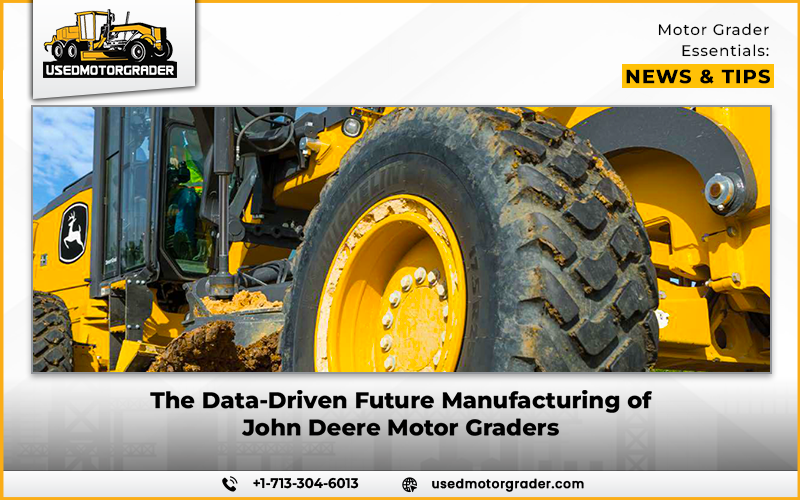John Deere motor graders are some of the most reliable machines in the road construction and earthmoving market. Yet behind their toughness and accuracy, there is a silent revolution: data-driven manufacturing. John Deere is transforming grader production and performance in the field by using big data, automation, and advanced analytics in its production. It is not merely about making the machines better, but ensuring that all the graders are smarter, more efficient, and fit the requirements of modern construction.
The Use of Data in Modern Manufacturing
Statistics have become the foundation of innovation in all industries, and the heavy equipment industry is not an exception. John Deere employs large flows of information to improve design as well as production.
- Big data and design: Engineers now examine real-world performance information to perfect blade precision, hydraulic systems, and structural durability.
- Predictive modeling: Simulation tools permit exploration of thousands of design variants virtually, long before physical prototypes reach the shop floor.
- Artificial intelligence and machine learning: These forecast stress points, material performance, and even operator requirements based on various job site conditions.
- Digital twins: Virtual copies of graders enable John Deere to test efficiency, maintenance needs, and design weaknesses in the digital world, saving time and resources.
Smart Processes in John Deere
John Deere has changed the construction of its graders through the integration of smart manufacturing. All the processes involved have been automated and data integrated.
- Sensors on robotic assembly lines allow the installation of components accurately.
- Real-time quality control systems instantly identify deviations, minimizing defects and rework.
- Cloud-based monitoring provides control over production plants to ensure uniformity and efficiency.
- Field performance data can prompt immediate design updates through digital feedback loops, creating a continuous improvement cycle.
Features Made Possible by Data-Driven Design
Information does not simply transform the way graders are constructed, but also what they are capable of doing on the ground.
- Precision blade control systems allow operators to achieve smooth grading with fewer passes.
- Fuel efficiency is enhanced by optimized engine and powertrain design, lowering operating costs.
- Ergonomic cabins and user-driven controls improve operator comfort.
- Lightweight designs and sustainable materials reduce environmental impact without affecting strength.
Data-Driven John Deere Motor Graders Benefits
For contractors, these data-based innovations translate into actual benefits:
- More uptime due to machines designed to be long-lasting and performance-monitored.
- Reduced maintenance costs as a result of predictive insights that identify service needs before breakdowns.
- Flexible work on a variety of job sites, from urban roads to major infrastructure projects.
- Increased resale value, because equipment with advanced technology remains competitive in the second-hand market.
Difficulties in the Transition to Data-Driven Manufacturing
Although the advantages are clear, there are also challenges in the transition.
- High initial investment in robotics, sensors, and advanced IT systems.
- Cybersecurity threats are associated with highly integrated production and machines.
- Training requirements for a workforce that must adapt to data analytics and digital tools.
- Balancing tradition and innovation: long-established mechanical skills must be combined with modern digital approaches.
The Benefits of Data-Enhanced Machines to Contractors
The John Deere motor graders designed with data-driven procedures have a direct effect on contractor efficiency and profitability.
- Faster project completion, as precision systems reduce the number of grading passes required.
- Less fuel usage, reducing costs and environmental impact.
- Consistent grading results, even in rugged conditions.
- Performance analytics that help fleet managers optimize usage and plan long-term.
Future Prospects of John Deere Motor Graders
The opportunities ahead are even more exciting.
- Growth of autonomous and semi-autonomous grading, reducing reliance on operator skill.
- Smart construction ecosystems that connect graders with other machines, drones, and software platforms.
- Stronger focus on sustainability, with reduced emissions and eco-friendly materials.
- Increased connectivity offering real-time operator support, resulting in fewer setbacks and greater accuracy on job sites.
Final Point
The production of John Deere motor graders is no longer just about producing heavy steel machines but about creating smart, efficient, and sustainable equipment. With data-oriented design and production, John Deere is keeping its graders aligned with industry needs. For contractors, this means machines that are accurate, dependable, and economical in the long run, helping keep projects on schedule and maintaining profitability in an ever-competitive world.
FAQs
Q1. What is the role of data-driven design in enhancing the longevity of John Deere motor graders?
A: John Deere strengthens key performance areas by analyzing real-world data and using predictive modeling to anticipate wear patterns before they become problems.
Q2. What are the main technologies at the center of the data-driven manufacturing of John Deere?
A: Technologies include AI, machine learning, cloud monitoring, and robotic assembly lines with precision sensors.
Q3. What is the advantage of predictive analytics to contractors who use these graders?
A: Predictive analytics allows forecasting when parts require service, which minimizes downtime, avoids unnecessary repair costs, and keeps machines ready for work.
Q4. Will John Deere motor graders of the future be fully autonomous?
A: The trend is toward more automation. While fully autonomous graders are still in development, semi-autonomous systems are already improving efficiency on job sites.


